|

FEEDING THE CREW OF A GEARING FRAM I DESTROYER
By Arnold Hofmann, CDR, SC, USN-Retired
At the time of this story, CDR Hofmann was
LT (jg) and the Supply Officer from 7/69-7/71
U.S.S. McKEAN (DD-784)
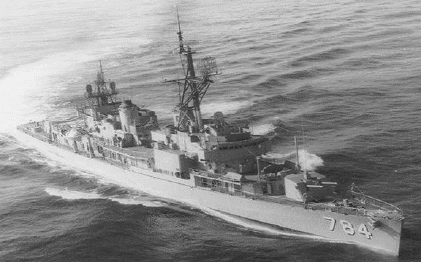 “Hey Cookie, what’s for lunch?” Feeding 250 enlisted
men 3 to 4 meals a day on a Gearing Fram I Destroyer with a half dozen cooks was
big job. It was one of those jobs where nothing was easy and as you finished one
meal, preparation for the next one would soon start. To make it a bit more
challenging, the designers of the Gearing Class Ships put the galley on the main
deck and the serving line and Mess Decks one deck below so that all hot food had
to be muscled down a steep ladder. In 1970, Commissaryman (CS), cooked and
served food for the crew in the general mess, baked, ordered, inventoried and
issued all food items aboard ship. They had a food budget and they had to stick
to it.
“Hey Cookie, what’s for lunch?” Feeding 250 enlisted
men 3 to 4 meals a day on a Gearing Fram I Destroyer with a half dozen cooks was
big job. It was one of those jobs where nothing was easy and as you finished one
meal, preparation for the next one would soon start. To make it a bit more
challenging, the designers of the Gearing Class Ships put the galley on the main
deck and the serving line and Mess Decks one deck below so that all hot food had
to be muscled down a steep ladder. In 1970, Commissaryman (CS), cooked and
served food for the crew in the general mess, baked, ordered, inventoried and
issued all food items aboard ship. They had a food budget and they had to stick
to it.
In addition to the Commissaryman supply
rating, a Petty Officer 1, 2 or 3 from some other division in the ship was
assigned to work for the Supply Department for a period of 90 days as Mess Deck
Master at Arms. Also, there were about 6 non-rated enlisted men from other
departments who would work in Supply as Messcooks and report to the Mess Decks
Master at Arms. They would assist in food preparation, operate the scullery and
clean the mess decks.
“Mess Gear,” passed on the
1MC was the notice to all hands that “Dinner for the Crew” wouldn’t be far
behind. Time to start salivating and getting washed up for the noon meal.
"Mess Gear" was passed on the 1 MC about 15 minutes before "Dinner for the
crew." When Mess gear was sounded the relieving watch standers and the messcooks
and commissarymen would eat.
At the head of the chow line there was
usually a MAA with a number clicker taking a head count of eaters. Sometimes it
was a messcook or a commissaryman but there was always a head count taken.
The reason for the count was twofold. First,
there was the ration allowance. In port, the ship was paid its ration allowance
for the number of people who ate the meal. At sea, the ship was paid the ration
allowance for the full compliment on board. This dictated how much money the
general mess was allowed to spend in any given quarter. For example, the ration
allowance in 1970 was probably about $2.50 per person per day for each person
that ate in port and for each person on board when underway (officers were not
included in this allowance count). The Chief Commissaryman and the Supply
Officer had to monitor the allowance vs. dollars spent so that they wouldn't
over spend the budget in any given quarter. Inventories were taken and returns
submitted to Washington, DC every quarter.
Sometimes, if you could see that you were
overspending, you would adjust the menu to less expensive fare for the last week
or two of the quarter in order to stay within budget. On the other hand, if you
were flush with money toward the end of the quarter, you would see a
proliferation of expensive menu items like steak and or lobster so that you
would spend it all.
The second reason for the head count was for
the Chief Commissaryman to better estimate the number of portions to cook and
thereby reduce waste and the possibility of over spending the food allowance.
The crew's menu was a 6-week
cycle menu. The menu for the specific week ahead in the cycle, would be
slightly modified by the Chief Commissaryman based on what fresh food was
available, what specialty foods the ship may have gotten from an underway
replenishment or in port, the weather, expected operations, or what he might
have run out of, BBQ on the helo deck, etc. Each line item in the cycle menu was
coded with a number that represented the Navy Recipe Card that was to be used in
the preparation of that item. The modified menu would be approved by the Supply
Officer and submitted to the Executive Officer for approval each week.
All menu cards were based on 100 portions.
So the Chief could assemble his cycle menu, review the cards for quantities of
food required, check the requirements against his inventory and place an order
for what was needed for a 90-day load out.
At the end of each meal, the Watch Captain,
as the senior cook for that meal was called, would document the amount of
leftovers for a particular menu item or estimate how much he was short of
another menu item. This info was then used to plan for the amount to cook of a
particular menu item the next time in order to reduce waste and have enough of
each item for any meal.
If liver and onions were on the menu, you would always
have another option because out of a crew of 250, you might only have 50 takers
for that item. The Watch Captain would also prepare extra food at the evening
meal to be used for midrats that were served for the watch going on the midnight
to 0400 watch and the guys coming off of the 2000 to 2400 watch. Only one cook
and probably one messcook staffed the galley for midrats so some pre preparation
was necessary.
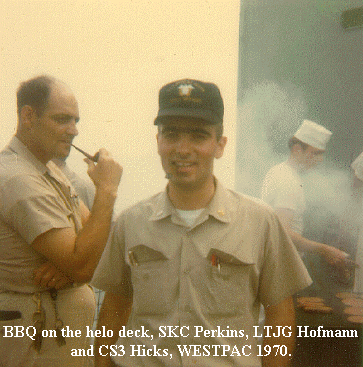
I’ve heard sailors tell stories about the
old days when powdered eggs were the norm rather than the exception. We nearly
always had fresh eggs on board. Powdered eggs were not a routine item. We had
pretty good replenishment from the Mobile Logistic Support Force that would
refuel us every few days and cycle out of Subic with FFV (fresh fruit and
vegetables). Milk was always a problem because we could only carry enough for
about 4-5 days from port. Sometimes the FFV was not in good condition when we
would get it out on the gun line so there would be periods of time without much
variety. Apples and oranges were usually available. Ice cream would only be
available for a few days because of limited freezer space.
I can't remember a specific week’s
menu, but there was pot roast, steaks, hamburger, pork chops, spaghetti, hot
dogs, macaroni and cheese, fish and lamb with potatoes and rice and typically
canned vegetables. There was always dessert. At sea we had a night baker who
would bake sweet rolls and fresh bread and rolls every night. Lunch would have a
hot meal choice and lunchmeat sandwich choices, grilled cheese and Ruben
sandwiches. Soup was a regular item with meals. Breakfast was typically eggs to
order, bacon, sausage, pancakes, chipped beef on toast, French toast, hot
cereal, toast, canned juice, and fruit if available.
Feeding Gearing sailors was
part of greasing the machinery that made the ship go.

In the interest of fairness,
here are some other views of chow by members of the Secret Scurvy Dog
Society.....
Back in 1952/53 on the Gearing, ERNEST G. SMALL
(DDR 838) there was NO Mid Rats, you got dinner and breakfast and engine room
coffee in-between, unless the BAKER phoned,,,, "whoop, whoop, whoop", "Aft
Engine Room", "Send the messenger to the inboard hatch". What a lovely man the
Baker was, warm fresh loves of bread, just out of the oven. With stolen butter
and maybe jam, it was a feast. Other nights I cooked potato soup. I'd go up on
the main deck to the potato and onion locker and steal some. Then I'd peel the
potatoes, cut them into chunks, and in an old tin can, add enough boiler feed
water out of the DA tank to cover them. Then the onion was peeled and chopped
and added along with a bouillon cube (care package from home) plus salt &
pepper. This was brought to a slow boil until it was soft enough to mash and
then some milk added just before serving. While it was cooking I would shut
down the lube oil purifier, clean it, put it back on line, and with my hands
covered in 2190T turbine oil, we would feast on cups of engine room potato
soup. I still make it that way today but the flavor has changed, probably cause
I ain't got any boiler feed water.... nor 2190T.
I can't recall a bad meal on
any of the ships I was on and enjoyed the liver and onions the best. The worst
meals were on a navy base and I can't remember which one, Yokosuka or Barbers
Point, while flying home.
Robert te Groen

During my short stint aboard the USS ORLECK
(DD-886), they had nearly run out of food. Some of the meals were ridiculous.
This was around March 17, probably the year 1979 or 80. I remember that date
because on St Patrick's day, they served green tinted mashed potatoes. I think
it was served with roast beef or something. It was a typical destroyer meal,
except that nobody was allowed second helpings. That fact turned out to be a
harbinger of things to come. Three days later, on the last evening before we
returned to port, the meal consisted of fried okra (all we could eat of this
delicacy), and one (ONLY ONE!) boiled hot dog. No
bun to go with the training aid, no salad, no milk. Nothing but Okra and one
dog. I have no idea what the story was behind this. It was highly unusual. We
returned to San Diego later, probably in the wee hours. I left the ship, and
returned to the McKean. Damn, it was good to be home,
again. Larry Pallozola

Lunch was the main meal on the USS
J.P.KENNEDY Jr. (DD-850). A variety of meals including Roast Beef or pork or ham
(lots of ham - might be served at all 3 meals). There was soup, Instead of meat,
we could have spaghetti. There was salad (although after a week or two at sea,
it was hardly palatable.) The lettuce would be frozen as would be the milk.
Dinner would have soup, main course and salad and dessert also but the meal was
generally lighter than what was served at lunch.
There was a shortage of refrigerator and freezer space. But
there was steak and seafood (fish was available every Friday) I think that most
ships tried to provide a variety of different foods within the confines of the
storage capabilities. Some ships did a better job than others.
The Kennedy in the mid-60's was a terrible feeder.
There was almost a mutiny the night that corn fritters and asparagus was served
for dinner. We had so much ham that it took me about 5 years after getting off
the ship before I would eat another piece of ham. After the blow- up, the Chief
Cook was relieved and we had an officer sample each meal (as was required by
Navy Regs.) The meal situation then improved. Len
Barrett

In my 22 years, I never had more than one bad meal
in a row. For the most part, the meals were very good. Sometimes there were shit
things on the menu, but there was almost always something that filled you.
When I made Chief, we feasted.
The only damned thing that used to piss me
off to no end, was the portions. When there was a working party or something
heavy to move they always (repeat: ALWAYS) wanted the big guys. Yet when they
served, the big guys were told that they didn't rate any more than the
fattyassed Yeoman or Postal Clerk. Used to burn my ass every time it happened.
Ken Dandurand

Remember those General Mills International
Coffees of the late 70's? Instant coffee that can in a can?
The TV ad went , "You know what this coffee reminds me of?" "That little cafe in
Vienna?"
I had a percolator in ASROC on the McKEAN. Naturally it had to have a grounded
plug put on by the EM. At sea we would stock up on bouillon, GM Inter Coffee,
cocoa and Ramen noodles.
I think we did it not so much that we needed the food but rather that it was a
pause from the routine. Dave Hood

Well I did 2 tours in the scullery, the McKEAN, & the
EVERETT. The first was because I just came aboard from boots, & the second
because I tried to give away all the food & pissed off the cooks. By the way
aboard the "Mighty Mac", we had a small lift from the galley down to the mess
deck. the Capt on the Mac gave me a special 72 hr pass because he stated during
inspection, that I had the cleanest scullery that he had ever seen in his 30
years of service. What he didn't know, I kept it super clean because when we
took on stores or ammo, that is where I would hide, also I would sleep inside
between meals if the cooks came up with some funky jobs for me to do. Aboard
the Everett in Hong Kong, I had 2 Chinese women helping me by cleaning the trays
of food, separating the trays & silverware & stacking them after they were
washed. Oh life in the good old days.
On the McKean, one evening meal a week, we had inserts of
fried onions, fried potatoes & onions, fried liver & onions, & brown gravy &
onions. I took a loaf of bread & a gallon of milk & went to bed, I knew tomorrow
would be better. Verner L. Newman III

I think this is so funny. We ate like kings on both the USS
WHIPPLE (DE-1062) and the USS HENRY B. WILSON (DDG-7). Can you guys imagine what I'd have
to say about the Navy if the food sucked??
On the Wilson, the wardroom food was
terrific, and the galley staff loved me. The cranks would sneak food to me in my
stateroom when I was hiding. I ate on the mess decks frequently too. The food
wasn't quite as good, but the company was usually better.
Bob Cohen

Damn, Arnie! Thanks for the lesson. I have wondered
for years why we got T-bone steaks to order and a lobster tail every three
months. We ate very well on the USS GEORGE K. MAC KENZIE (DD-836). The
Supply Officer had no sense of humor whatever and less personality but he was
very good at his job. We didn't have a Chief Commissaryman. We got by with a
great E-6. He would occasionally ask us if we liked a particular entree. He kept
the galley clean. When the ship was fumigated the only place they found roaches
was the scullery. They carried them out in bags. I had never seen a roach before
that but the FTs and IC Electricians who shared the passageway with the scullery
said they came out at night. Terry Miller

What was the food like on a
Gearing? Well on the USS CHEVALIER (DD-805): it was excellent (Mess deck),
excellent (Chief's Mess) and excellent (Wardroom). It was almost the same menu
except CPO's and O's got more salad and "O" 's could eventually spring for
Japanese "Kobe" steak, etc. On a pay as you go deal. I ate one meal a week on
the mess deck and I rarely found fault. But that was a function of the Supply
Officer, to have great food around the clock! I was blessed (my ship was
blessed) with three Supply Officers in a row that were determined to have good
food service. And we did have great food. Only three times in three years did I
write a "Negative" report about the Enlisted Mess. And if I recall correctly,
within 20 minutes after I reported a negative report about Mess Deck food, the
Supply Officer asked for a meeting, asking "what was wrong with that meal?". I
would tell him whatever was wrong. And then he went to work to fix it! That is
the way it should be! One officer (other than the Supply Officer) each day
should and did eat in the Crew's Mess and report to the CO (noon report) whether
the food, and food service, met the minimum standards for a Naval Ship. With a
carbon copy to the Supply Officer and several Chief's. The system worked! Some
destroyers were known as "feeders". Chevalier was in that group! Man, was I
blessed or what? Richard King

Our esteemed President (Bob
Cohen) for Life has a different view and time frame of food on the USS HENRY B.
WILSON (DDG-7). When I had the pleasure or displeasure, as the case may be, to
be a member of the Hammerin' Hank's crew, it was usually feast or famine. The
famine part was always when we were at sea. Depending upon the length of time
spent at sea, it would go from steak, lobster, fresh salad greens and so on, to
hot dogs, frozen hamburger patties, shredded cabbage for salad and bug juice.
Fresh milk and fruit were just dreams we had in our
sleep. With extended sea time, these things became just memories. Fresh eggs,
milk, fruits and vegetables quickly became luxuries. Granted the Chief Cook
wasn't worth a damn in ordering stores, that is one of the reasons he was
relieved of his post and the First Class took over. The menu became much better
over time, but never did approach the inport fare.
The last I had heard of the Chief? He was in charge of ordering stores for the
enlisted mess in San Diego! James Crawford

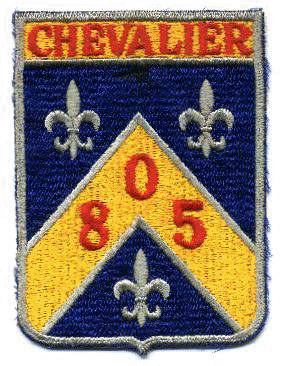 As an "O" (officer) "tasting the crew's mess" I always felt very uncomfortable.
I always waited in line; some officers doing the same job "ranked" their way to
the front of the line. But the "uncomfortable" moment would occur after I had my
tray and I was looking for a seat. On USS CHEVALIER (DD-805) (all ships were
different) all of the mess deck tables sat four. I would frantically look for a
table with a vacant seat with some sailors I knew. That might be M or B
Division, but possibly R Division, OE Division, OI Division or possibly X
Division, whatever I could find. Why the discomfort? Imagine, you are say an E-4
or E-5 Weapons type and trying to enjoy your noon meal and some "O" from the
Engineering Department that you don't really know comes and sits down next to
you uninvited? I was very attune to that. Sometimes I would spot a seat almost
vacated at a table with sailors I was comfortable with, i.e., I knew their
names, home towns, etc. I would stall at the beverage table hoping the seat
would vacate in time. Does this make any sense?
As an "O" (officer) "tasting the crew's mess" I always felt very uncomfortable.
I always waited in line; some officers doing the same job "ranked" their way to
the front of the line. But the "uncomfortable" moment would occur after I had my
tray and I was looking for a seat. On USS CHEVALIER (DD-805) (all ships were
different) all of the mess deck tables sat four. I would frantically look for a
table with a vacant seat with some sailors I knew. That might be M or B
Division, but possibly R Division, OE Division, OI Division or possibly X
Division, whatever I could find. Why the discomfort? Imagine, you are say an E-4
or E-5 Weapons type and trying to enjoy your noon meal and some "O" from the
Engineering Department that you don't really know comes and sits down next to
you uninvited? I was very attune to that. Sometimes I would spot a seat almost
vacated at a table with sailors I was comfortable with, i.e., I knew their
names, home towns, etc. I would stall at the beverage table hoping the seat
would vacate in time. Does this make any sense?
Third independent thought
in the same message, you have probably wondered and pondered for years and years
what the most frequent complaint was from E-6 and below about the USS CHEVALIER
mess deck. Toss and turn in your sleep no more, I will reveal my scientific and
empirical research on this subject. Was it "SOS" (no, "shit on a shingle" was
actually liked by many including myself). Liver and Onions? Well, when that was
served they always had an alternate. Horsecock sandwiches? Actually, they were
good. Peanut butter and jelly sandwiches for midrats? Tasty! No (keep this
confidential, it might still be classified) the biggest most frequent complaint
from and about the Mess Deck was about the
damn glasses.
There were not enough of
them so the scullery would wash them at over 250 degrees F and re-cycle them in
less than three minutes, still so hot you could barely pick them up. BMSN
"Smith" would walk up to the stainless steel "milk cow" dispensing genuine cold
Vitamin D whole milk (not powdered), grab a "red hot" glass not twenty seconds
from the scullery, add milk and it would curdle, the milk was ruined. One day I
went to Charlie (the Supply Officer) and explained this complaint that I had
heard about over and over for a long period of time. Well, he fixed it! Cases
and cases of glasses were brought on board and lunch glasses were not recycled
until supper. Charlie was smart! Simple solution to a simple problem. Charlie
was also the one who managed to deliver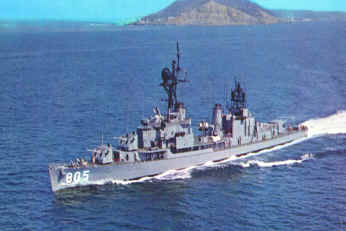 "eggs to order" within the confines of a Gearing Mess Deck serving line. He
worked on that project for over a year and had a tough time getting the money to
buy the equipment. But he succeeded. By the time Charlie was relieved by a new
Supply Officer, Dave Foy in 1968, at breakfast in the morning (at sea or in
port) sailors could order their eggs at the top of the chow line (scrambled,
fried or "over easy" and by the time they got to the line at the bottom of the
ladder, they were ready "as ordered". Plus all the sides of their choice.
"eggs to order" within the confines of a Gearing Mess Deck serving line. He
worked on that project for over a year and had a tough time getting the money to
buy the equipment. But he succeeded. By the time Charlie was relieved by a new
Supply Officer, Dave Foy in 1968, at breakfast in the morning (at sea or in
port) sailors could order their eggs at the top of the chow line (scrambled,
fried or "over easy" and by the time they got to the line at the bottom of the
ladder, they were ready "as ordered". Plus all the sides of their choice.
Next time you are on a
Gearing, take a look at the amount of space available for this achievement.
Prior to this, eggs were scrambled in the galley (main deck), heaped into huge
hot trays, hand wrestled down the ladder to the serving line "hot stuff, hot
stuff" and placed on the steam table. As you went through the line, they might
ask "how do you want your eggs?". No matter what you said, a big spoon would
dollup up a serving of previously scrambled eggs and "dollup" them onto your
tray. Next! Richard King

While anchored at the base in Boston the skipper and mess
sgt would go down to the Boston fish market and purchase several crates of
lobster. Man we had baked, fried boiled, chopped lobster for a whole weekend.
When approaching the coast of South Carolina we would have a fishing boat pull
up along side and they would deluge us with lobster, crab, scallops and tuna. we
ate petty good I must say.
Frank Kelson

From my perspective as a young E-3
or E-4, Mess Gear Sounded at about 11:30 AM. Standing in line began at that time
and when the seas were relatively calm, aboard the FRAM I can, USS J.P.KENNEDY
Jr. (DD-850), that meant getting
in line along the port side.
The first 10 feet of the port side consisted of the hatch, leading into the main
deck. If you turned left, you went into the wardroom. That was OFF LIMITS. If
you took an oblique right, you entered the main deck passageway, leading past
the wardroom galley, the ships galley and towards the aft end of the ship.
However, if you took a sharp left and were alert, you went down a ladder leading
to the steam line and walking forward then the mess decks.
You looked left and picked up your
metal compartmentalized tray, soup bowl and silverware. Walking past the steam
line, you chose which of the varied and plentiful (unless you were at the end of
the line) fare that was offered. Leaving the steam line, lift your legs to get
past the knee knocker in the hatch and enter the mess decks.
The MESS DECKS - a conflagration of 12 to 14 tables that sat 4 people eat. (Some
of the tables may be occupied by various and sundry gear of assorted variety.)
This leaves at most 56 seats for a crew of 250 minus 10-12 Officers and about 13
or 14 Chiefs equals 224 enlisted folks.
Think about 224 people trying to
eat in one hour, or perhaps 1 hour 15 minutes. That leaves about 15 minutes per
person eating time. Again, this assumes that all seats are available and that
all matters requiring attention have been taken care of. The average eating time
from soup to dessert may actually be closer to 12-13 minutes.
For most folks, the name of the game was getting through the dinner meal as
quickly as possible to catch the sun (on
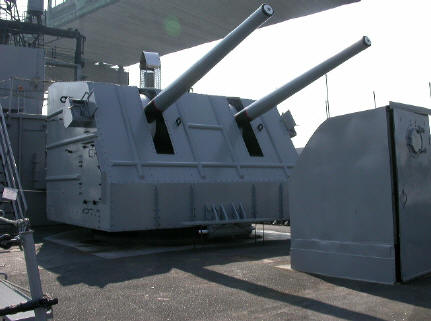 sunny days
and in warm climes), play the quick game of cribbage or otherwise complain about
the morning duties. They might even take a nap on the deck if they had not gone
to their rack/bunk. sunny days
and in warm climes), play the quick game of cribbage or otherwise complain about
the morning duties. They might even take a nap on the deck if they had not gone
to their rack/bunk.
Many gathered on the stern end of the ship known as the fantail. In this way,
because even if there were a stray wave they could generally stay dry. On
this particular day, the ship was steaming along in the southern portion of the
North Atlantic ocean. Somewhere between the Bahamas and Florida. This particular
seaman decided to take a nap. The nap was to be in the shade of Gun Mount 52.
This Seaman was sound asleep using the STOP - that piece of
solid steel that was welded to the deck so that the gun mount could not turn all
the way around and possible fire the gun into the ship - as a head rest.
When one is sleeping a deep and sound sleep, such nonsense as SECURE THE MESS
LINE will never be heard. Nor will the sound of the GONG, GONG, GONG GENERAL
QUARTERS, GENERAL QUARTERS, ALL HANDS MAN THEIR BATTLE STATIONS be heard.
However, there is only one sound that hopefully will be
heard. When the Gunners Mates man their stations they check out their equipment
including training their gun for both direction and elevation. Training the gun
requires that the gun mount be turned. When the gun mount is turning a bell
sounds to let anyone outside the mount know to get out of the way. That sound of
the bell as the gun mount is turning was in fact the only thing that let this
young sailor know that he was within 20 degrees of getting his head caught
between the gun mount and the gun mount stop that he was using as a pillow.
Besides the rude awakening, there were many questions to be answered to the
Chief of the Radar Gang when this young seaman finally reported to his GQ
station. The other besides is that he never, NEVER, NEVER again used the gun
mount as a pillow!
Len
Barrett

 

|
